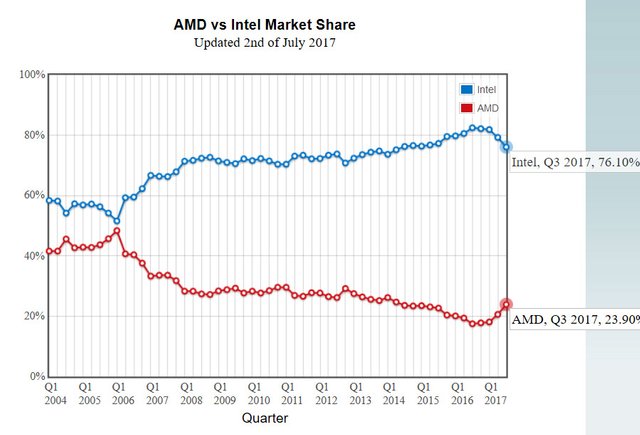A Place For AMD in 2018 and On

Much like any market in which there are enthusiasts, there are two primary bell curves in PC tech: The tech that people are interested in, and the tech that people actually buy.
Those two bell curves do not always coincide. In fact, it’s extremely rare that they ever do so. For example, a lot of people care about the Nvidia GTX 1080ti and the Intel 8700k, but one glance at Steam’s hardware statistics will make it plain that not everyone who is interested in those products actually buys them. The general PC gaming population, on average, buys products that cost substantially less than those top-tier ‘halo’ products, even though those products garner the majority of the spotlight.
In actuality, these two bell curves act a lot like a Venn diagram. The Interest curve is, by and large, offset higher than the Purchase curve, but there IS a ‘sweet spot’ where the two overlap. This is generally known as the ‘Price-to-Performance’ or ‘Bang-For-Your-Buck’ zone. It’s where the majority of PC component customers actually have the means to purchase products that they are genuinely interested, even if they’re not the products they’re the MOST interested in. Instead, they buy the products that they are most interested in within the confines of their individual budget.
For a very long time, Intel has had a near-monopoly on both bell curves within the CPU market and Nvidia still has a near-monopoly within the GPU sphere. In regards to CPU’s, Intel gained market dominance through a multitude of methods, including effective broad marketing techniques, OEM partnerships, thorough software optimization, and a competent range of products that generally performed better than their AMD counterparts via either less power or less money. While the CPU market has gone through a major shake-up over the past year, this is still the case with Nvidia and the GPU market, especially with the debacle that has been the discrete Vega product line.
However, the downside to this kind of market dominance is the inevitable onset of overconfidence and complacency. For years, Intel has dominated the high-end component market and they have basked within the bragging rights that are inherently included with that accomplishment. However, hubris being true to its nature, Intel has made the mistake of leaning far too heavily on those bragging rights and expecting the results of that hype to trickle down by way of course to their more affordable products. For a while, this was an effective strategy- not because they were validated in their confidence, but simply for lack of alternatives.
During that time, AMD made...efforts? In all honesty, AMD was guilty of doing the same thing Intel has recently been called out on, such as releasing evolutionary updates that did little to correct their innate flaws or boost the strengths of their products. Their products provided too little performance, drew too much power, and thus generated too much heat. While they were generally more affordable than the Intel competition, the delta in price-to-performance to was simply too great and most people decided to tighten their belts that little bit more in order to drop their money on the more polished and more well-optimized Intel product.
However, I am of the opinion that during that period of time, AMD was simply distracted. They knew they would have to bring out something groundbreaking and really rock the boat, so they began focusing on maximizing the impact of their next architecture. As a result of the reallocation of resources, they simply didn’t have the means to do more than incremental updates to their already-defunct AM3 and AM3+ architectures. They did just enough to still exist as an active presence in the market, but it seems fairly obvious to me that their attention was elsewhere: AM4.
Nearly a year ago, that entire desktop CPU paradigm was flipped on its head with the release of the Ryzen AM4 architecture. Suddenly AMD was bringing something fresh to the table that not only performed better than the similar-tiered Intel offerings, but did so for less money and while consuming less power. Not only this, but every chip was unlocked for overclocking right out of the box, narrowing what performance gap there was even further.
Suddenly there was a new price-to-performance CPU king and, most importantly, the hype and marketing of its release placed Ryzen squarely in that highly sought-after conflux where both aformentioned bell curves overlap. It was a perfect storm of price, performance, and timing, and one that Intel, grown complacent as they had, was completely unprepared to answer. For the first time in a long time, Intel found themselves giving up actual market share.

Intel did eventually answer, of course, and that answer, skipping the pointless and rushed Kabylake refresh, was Coffeelake. While highly anticipated, the reactions to Coffeelake were somewhat tempered by the fact that while they maintained their absolute top-tier performance crown, the products that were priced nearer to the Ryzen competition simply couldn’t compete in regards to performance, efficiency, or features. The tables had turned and the low and mid range Coffeelake chips became the Intel equivalent to the FX series from AMD- an evolutionary advancement that didn’t improve substantially enough in enough areas to justify its own existence.
Nevertheless, Intel and its 8700k, along with the other k chips just below the 8700k, maintain those very same bragging rights. The 8700k, as hot and power-hungry as it is, is the best of the best and there’s no denying it. Sure, Ryzen still offers an unbeatable performance value, but if someone just wants the absolute best of the best for gaming and single-core performance and has the financial means to make it happen, then Intel is the obvious choice in the same way the Nvidia GTX 1080ti is entirely uncontested in the high-end GPU market.
Ever since the launch of Ryzen, then Vega, and now the Raven Ridge APU’s, there has been a general outcry, either in the form of AMD fans pleading to AMD or Intel/Nvidia enthusiasts snubbing their noses, about the fact that AMD cannot seem to break into the truly high-end gaming component market where Intel and Nvidia have a death-grip on the halos. However, with the tidal wave of positive reviews rolling in for the Ryzen 2200G and 2400G, I’ve been thinking about the effect these new chips have had on the budget market and the wider-ranging ramifications therein. After a healthy amount of thought on the subject, I would take to ask AMD to consider a different approach when it comes to competing with Intel and Nvidia: just don’t bother.
Don’t misunderstand- I don’t mean give up on creating and releasing new products altogether. What I mean by this is don’t try and compete with Intel and Nvidia on their terms; don’t play their game. Let them have those halo products, let them maintain their firm grasp on that first bell-curve, and let them funnel the tremendous amount resources required to maintain that position. It’s not your problem- that’s not your wheelhouse. Instead, go back to that second bell curve and those Steam statistics. Focus on what those numbers really mean, because that is your domain. That is where you can thrive if you just stay the course you have so effectively laid out for yourself.
With your Raven Ridge APU release, not only have you once-again garnered a hefty amount of positive press, you have completely obliterated the ultra-budget GPU market overnight in the process. Once again you have placed a sudden and fairly unforeseen stranglehold on a market segment that had been previously viewed as secondary or tertiary in the eyes of your competition. This is what some of the more douchey among us would call an Underserved Market- a market you have swept in and served with sudden aplomb. From $99 to $299, any CPU that doesn’t have ‘Ryzen’ in the name is questioned and doubted, with an undertone of “But why not Ryzen?” You cannot ask for a better position in a given market.
Let’s be real, here. Yes, the 1080ti and 8700k are the cream of the crop and they are the products that everyone wants. However, they are in no way the products that everyone buys. Why? Because most of use simply can’t afford them. The bell curves just don’t overlap for enough people when it comes to those top-tier items. The market dominance of products like that is a needlepoint of high profit margin- a high-risk-high-reward approach such as that just does not suit Ryzen. Ryzen is the smart option. Ryzen is the safe bet. Ryzen makes sense for the vast majority of real people with realistic budgets.
So let Intel and Nvidia keep their spotlight at the top of the pyramid and let them keep their gaze skyward instead of paying attention to the foundation upon which they are perched. Keep just enough pressure at their feet to encourage them to continue dumping resources into products that gain 99% of the attention, but only reap 1% of actual sales. While your competition is preoccupied with stroking their own egos via benchmarks, world records, and functionally irrelevant sky-high framerates, you will be honing your dominance of the other 99% of consumers who simply can’t justify the expense that goes with those top-tier products.
Those consumers will look at the 8700k and the 1080ti, then look at their wallet and say to themselves, “Well, I obviously can’t afford those, so what’s the best product that I CAN afford?” And there you’ll be, AMD- the performance value that’s actually in their league. Let Intel and NVidia run themselves in circles and instead maximise your presence in the ‘Price-to-Performance’ segment. If you can maintain the momentum you’ve built up by continuing to innovate at an appealing price, AMD will no longer be the CPU or GPU customers have to settle for; it will the smart option that just makes sense.
Congratulations @wrenchviking! You received a personal award!
You can view your badges on your Steem Board and compare to others on the Steem Ranking
Do not miss the last post from @steemitboard:
Vote for @Steemitboard as a witness to get one more award and increased upvotes!
Congratulations @wrenchviking! You received a personal award!
Click here to view your Board